Science
The Solar System’s first
interstellar visitor
’Oumuamua revisited
There have been a number of explanations for
this peculiar interstellar wanderer.
Some are natural and mundane while
others are more exotic.
Some are even decidedly SFnal.
Duncan Lunan gives us
the run down on the various hypotheses.
Quick links to sections below:-
Introduction
The Extraterrestrial Hypothesis
‘Natural’ Explanations
Astronautical Explanations
Purposeful Explanations
Introduction
From the invention of the telescope until 2017, and as far as could be told from older astronomical records, no asteroid or comet coming from interstellar space had ever been detected. Harlow Shapley had postulated the existence of stray interstellar planets, and those have since been discovered, giving a pretty strong reason not to build Dyson Spheres. It stood to reason that there might be populations of smaller objects out there, and in their book The Cosmic Serpent Drs. Victor Clube and Bill Napier had suggested that the Oort Cloud could be composed of comets which the Solar System has swept up in passages through interstellar clouds.(1)
But nothing unmistakably travelling at above Solar System escape velocity was detected before the oddly-shaped A/2017 U1, also called C/2017 Pan-STAARS after the telescope which detected it in 2017 passing through the inner Solar System. It was given the Polynesian name "`Oumuamua", translated as ‘Scout’. Omoo, meaning a person who wanders from island to island, is the second of Hermann Melville’s semi-autobiographical accounts of adventures in the South Seas, and is the name of the online international beachcombing society in Mark Douglas-Home’s novel The Sea Detective.(2)
Coming from ahead of us, near Vega and the Apex of the Sun’s Way (the point we are – the Solar System is – heading for, in the constellation Lyra), `Oumuamua traversed the inner Solar System in September and October 2017, leaving it at 27 kilometres per second in the direction of Pegasus.(3) At first, it was thought to be a comet, (4) but then re-designated as an asteroid when it was found to be 400 metres long yet only 40 metres across and not having any discernable tail.
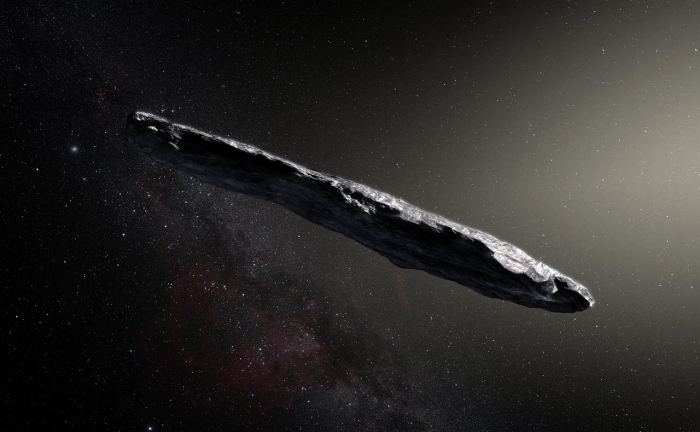
Fig. 1. Oumuamua apparent shape.© M. Kornmesser, European Southern Observatory.
© ESA. Reproduced under Creative Commons Attribution 4.0 International License,
The peculiar shape immediately led to suggestions that it might be a starship, and indeed its shape was reminiscent of the one in the 1985 film Lifeforce, based on the novel The Space Vampires by Colin Wilson. (Black marks to anyone who didn’t know Lifeforce contained any shape other than the film’s Mathilda May’s.) My first professional SF story sale had been ‘Derelict’ in 1967,(5) about a deserted starship falling into orbit around the Earth, and there was a certain irony in that both my first story and my most reprinted one, ‘The Comet, the Cairn and the Capsule’,(6) became topical again within a few weeks of one another.
In the latter story, astronauts penetrated the head of the first interstellar comet, to plant an instrumented probe which would ride out of the Solar System with the nucleus – only to find a cairn of similar packages, deposited by other civilisations over a very long timescale. That idea is highly relevant to `Oumuamua, as shown below. The story also proved prophetic in a backhanded way: the action took place on the terminator of the nucleus, which hardly moved during perihelion passage. I felt doubly guilty about that piece of poetic license when it was reprinted in The Science Fictional Solar System, edited by IsaacAsimov, Martin Greenberg and Waugh, and Isaac Asimov said that it “pictures a Whipple-like comet with considerable accurate detail”.(7) I hadn’t intended to fool him, especially when he, Carl Sagan and Arthur C. Clarke had all given me unlimited permission to quote from their work, at an early stage of my career. In real life the rotation couldn’t remain in synch in that way, and that too is relevant to `Oumuamua – see below.
 Fig. 2. The interstellar ‘prison-world’ of Rhaam, trapped in decaying orbit around Saturn. Cover painting by Sydney Jordan for Jeff Hawke’s Cosmos. vol. 5 (2), June 2009, illustrating ‘Out of Touch’, story by Harry Harrison, artwork by Sydney Jordan, originally Daily Express 4.10.1957 – 5.4.58. Painting reprinted in Lunan, D. (2019) From the Moon to the Stars, Space-Travel Stories by Duncan Lunan. Other Side Books: . © Sydney Jordan, 2009. Reproduced with permission.
|
Further observations of its light curve suggested that `Oumuamua was faceted, and artists’ impressions of it (Fig. 1) reminded Sydney Jordan fans of the hollow ‘prison-world’ of Rhaam, trapped in decaying orbit around Saturn in the Jeff Hawke story ‘Out of Touch’, written by Harry Harrison in 1957.(8) (Fig. 2) That was long before Arthur C. Clarke’s Rendezvous with Rama (1973) and even its source of inspiration, Islands in Space: the Challenge of the Planetoids by Cole and Cox (1964),(9) so the similarity of names (‘Rhaam’ and ‘Rama’) is presumably a coincidence.
`Oumuamua was monitored by the Green Bank radio telescope, part of the Breakthrough Listen SETI programme, but no signals were detected.(10) It seemed that at least one of its facets was dark red in colour,(11) and its spectrum matched those of objects in the Kuiper Belt, probably due to tholins generated by the action of ultraviolet light on organic compounds. (12) It’s thought that ices are driven off in the same process, and as `Oumuamua left the Solar System it was found to be slowly accelerating, perhaps due to faint out-gassing due to solar heat belatedly penetrating to the interior.(13) Halley’s Comet underwent some sort of explosion in the outer Solar System in 1990, more than four years after passing the Sun, apparently for similar reasons.(14)
If it’s an asteroid or comet, `Oumuamua’s shape and its tumbling are thought to show a violent past, (15) like Saturn’s weird moon Hyperion, and it may be a collision fragment expelled from a double star system.(16)
Scientists at the Max Planck Institute have tracked back `Oumuamua’s path and, using data from the Gaia satellite’s all-sky astrometric survey, they identified four possible candidate stars, assuming that the object hasn’t been anywhere else since escaping.(17) The star that was closest to `Oumuamua, about one million years ago, is the reddish dwarf star HIP 3757, which it passed within about 1.96 light-years, though at a relative speed of around 25 km/s (16 miles/s) making it less probable for this to be `Oumuamua’s home.
The next candidate, HD 292249, a yellow-white G5E star similar to our Sun, was a little bit less close to the object’s trajectory 3.8 million years ago, but with a smaller relative speed of 10 km/s (6 miles/s).
The third candidate star in the Gaia catalogue is Gaia DR2 2502921019565490176, termed “home-3” in the study. `Oumuamua would have been within 2 light-years of it, travelling at 14.3 km/s, 6.3 million years ago. Gaia DR2 3666992950762141312, “home-4”, was within 2.9 light-years 1.1 million years ago with a relative velocity of 18 km/s.
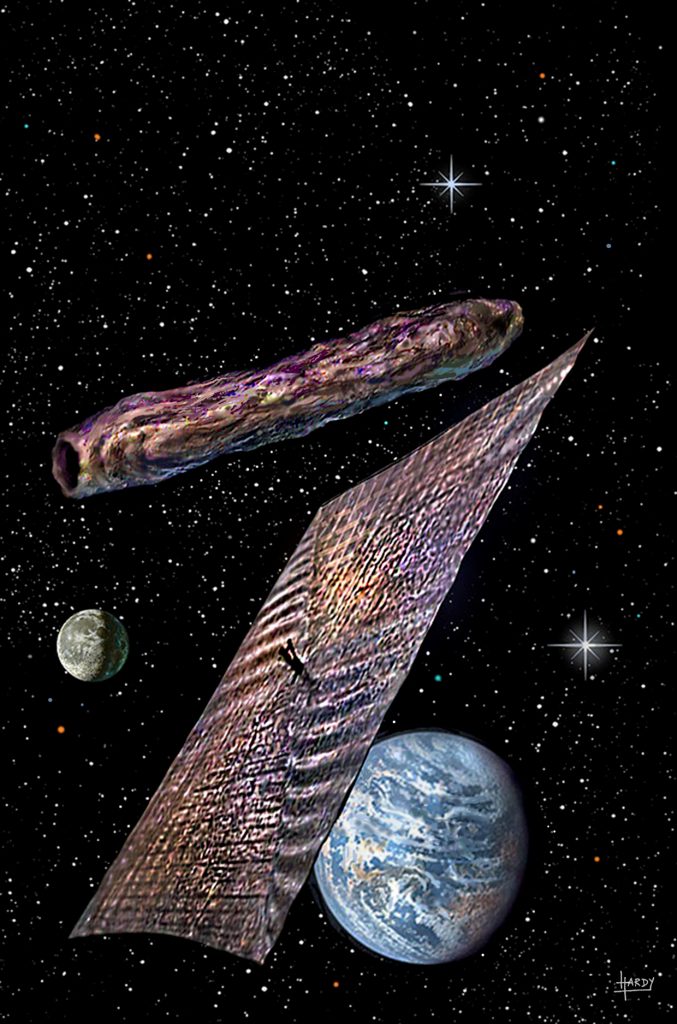 Fig. 3. ’Oumuamua as solar sail or asteroid. © David Hardy, June 2021. Reproduced with permission. |
The Extraterrestrial Hypothesis
Meanwhile, the issue of artificiality was then reignited by Shmuel Bialy and Abraham Loeb (one of the founders of Breakthrough Listen),(18) who argues that `Oumuamua is probably an extraterrestrial artefact, most likely a solar sail. Because of its odd shape and because it went close to the Sun, if its acceleration was due to out-gassing, `Oumuamua should have heated up and become active much more rapidly, but even now, no emissions have been observed, not even by SOHO or STEREO, both of which would have detected dust or water vapour, nor by the Spitzer space telescope, which would have detected carbon dioxide. Spitzer's infrared telescope should also have detected the heat, but didn't, proving that 'Oumumua is highly reflective.
Also, out-gassing on that scale should have affected the object’s spin rate, but that remained unchanged. If instead the acceleration was due to radiation pressure then ’Oumuamua would be much less massive than believed, and the best fit appeared to be an extremely thin sheet (less than 1 mm thick) about 40 metres in diameter – in fact that was the best fit to the light-curve, with 91% probability, and Loeb is more than a little annoyed that the cigar-shape dominates almost all the published artwork.(19) Fig. 3 is a rare exception.
Another exception was a painting by William K. Hartmann, senior scientist emeritus, Planetary Science Institute, Tucson, Arizona, commissioned by Michael Belton, of Belton Space Exploration Initiatives, Tucson.(19a) Belton’s group had established that `Oumuamua could have biaxial or even triaxial rotation, with periods ranging between 6.58 and 54.48 hours. While the spindle shape was likely to be correct if the periods were long, the best fits to the light-curve were ‘an extremely oblate spheroid’ if the periods were longer. (19b) At Belton’s request, Hartmann portrayed `Oumuamua as a thick disc (Fig. 4), like the ‘saucer section’ of the Kuiper Belt object 2014 MU69, ‘Ultima Thule’, now renamed ‘Arrokoth’ after the New Horizons flyby of January 2019, and that painting is now been used extensively to illustrate a different hypothesis (see below). But if it is a disc propelled by light pressure, then it has to be a very thin one, as above.
`Oumuamua might be a lightsail-powered probe, or a derelict lightsail adrift in interstellar space. Although its material would be very thin, it could survive kiloparsecs of travel. Prof. Loeb has now expanded his arguments in his book Extraterrestrial, the First Sign of Intelligent Life Beyond Earth.(19) The book is written to be accessible to general readers, so it pauses to explain many basic concepts as it goes along, but nevertheless it repays careful reading. It contains a great deal more than the `Oumuamua issue, and the last third of it contains stimulating thoughts about new initiatives which Loeb believes are needed to shake up the search for life beyond the Earth, including intelligent life, and, beyond that, new approaches to science in general and how to inspire the young to take part in it. There would be much to discuss, were it not that the main topic is so important that it has to take priority, because his case for `Oumuamua’s artificiality is a great deal better than media coverage would have us believe.
Loeb gives some space to the reactions which his thesis has met with, and here I have to sympathise. In 1967, the late John Macvey drew my attention to the suggestion, made by Prof. Ron Bracewell of Stanford, that a probe from another civilisation might have tried to contact us by radio in the 1920s. Researching it in 1972, I stumbled on what appeared to be a coherent translation of the apparent messages, which was published in part by the British Interplanetary Society in 1973. (20) The story was international news for several years and made my book Man and the Stars a minor best-seller.(21) Major parts of the translation proved to be invalid and I withdrew it in 1976,(22) though it continues to lead a life of its own, misquoted, on UFO websites. (23)
I’ve described the reactions to it, worldwide, in my guest chapter for the late Chris Boyce’s book Extraterrestrial Encounter.(24) I received about 2,000 letters from all over the world, every continent including Antarctica, and most states of the USA and USSR. None of the ones from members of the public expressed hostility; that came only from professional scientists, mostly reacting to the press coverage rather than the published work. But there were a significant number of complaints that as an amateur scientist, I had no right to do it; or that it should not be done at all. Sir Bernard Lovell said to me, “If we find ourselves studying a phenomenon which cannot be explained by any known physical process, we must not allow ourselves even to consider that it may be artificial”. Sir Bernard gave a similar statement to The Times in 1974, but at the time he was probably influenced by his colleague Prof. Zdenek Kopal, who had written “If we hear the ‘space-phone’ ringing in the form of observational evidence which may admit of no other explanation, for God’s sake let us not answer”, (25) and who said to me, “You must agree that it is better to ignore these things than to investigate them”. (Sir Bernard took a more positive attitude to SETI when interviewed by Stanley Kubrick in the 1960s, (26) and again when the interviews were updated in 2005.(27))
As the longest-serving chair in the history of Harvard’s astronomy department, Loeb could hardly be told that he had no right to contribute to the field, but he has encountered plenty of criticism to the effect that he has let the side down by writing on SETI. Despite the public impression that it is cutting-edge science, he has formed a deep impression that the majority of scientists regard the subject as without legitimacy in all its aspects, let alone in anything to do with extraterrestrial visitors or interstellar travel. Around the same time as Loeb’s thesis became news, a giant solar sail was suggested as a possible explanation for the mysterious obscurations of ‘Tabby’s Star’, and Universe Today commented, “It’s not aliens. It’s never aliens.” Loeb takes issue with that in the book, for the same reasons that I gave in Extraterrestrial Encounter: there is no justification for cutting off discussion of such an important topic, and the effect of such negativity on young scientists and would-be scientists is bad for the field all round.
Because of his participation in Breakthrough Starshot, which proposes to send micro-light-sails to the nearer stars, Loeb is often dismissed with the German proverb, “To him who has a hammer, everything looks like a nail”. Loeb’s excellent reply is, “Not only do skilled carpenters most definitely not see nails everywhere, but they are trained to differentiate among those they do observe”. Differentiation is the key word: his point is that `Oumuamua is not like anything we have seen before, and needs a different kind of thinking, rather than trying to force it into familiar categories. Below, I’ll suggest another couple of aphorisms and quotations he might find useful.
`Oumuamua is much more reflective than any known class of asteroid or comet, with an albedo near 70%, as reflective as the clouds of Venus, equivalent to polished metal. It has no similarity to the two other interstellar objects detected since. One of these subsequent visitors was an asteroid captured by the Solar System in its early history,(28) and the other the fairly normal Comet Borisov, whose composition resembles comets of our own Solar System, particularly Comet Hale-Bopp (1996).(29) Both appear to have formed in the outer reaches of their systems, but incorporating material originating from much further in, and have seldom if ever passed close to a star before.
‘Natural’ Explanations
In this context, Loeb is experiencing a frustrating phenomenon which I have encountered in several other cases. Someone comes up with a ‘natural’ explanation for one aspect of whatever’s under study, and then dismisses all the other oddities with the words “…and we can disregard the rest”. Among “the rest” for `Oumuamua is that its acceleration away from the Sun was absolutely uniform, diminishing with the inverse square of the distance, as it would if it was purely a reflection effect. To achieve that acceleration by the rocket effect of expelled material, 10-40% of the total mass would have to be lost, and the spin rate would inevitably be altered. No such alteration was observed. In addition, if the acceleration is due to any form of out-gassing in response to solar heating, it cannot remain steady if the body tumbles, especially with a period as long as 8 hours.
Yet despite that, two hypotheses have been put forward which would explain nothing except the non-detection by STEREO, SOHO and Spitzer.
The first was that `Oumuamua was composed primarily of solid hydrogen, which would have been undetectable by the three spacecraft as it boiled off. Prof. Loeb and his colleagues had no difficulty in showing that such material would have been sputtered or boiled away by cosmic radiation during the timespan of an interstellar journey.(30) The second, recent suggestion was that instead it was composed primarily of solid nitrogen, like parts of the crust of Pluto, and it had been expelled from such a surface.(31) To their credit, the authors of that suggestion, Alan P. Jackson and Steven J. Desch, don’t take a ‘we can disregard the rest’ approach, and do look at the evidence in depth; but others have had no trouble doing it for them. One such YouTube commentary, headlined ‘’Oumuamua Finally Explained Using a Brilliant Hypothesis’,(32) began with an ad hominem attack on Loeb for suggesting artificiality only to seek personal publicity (as if there was no publicity to be had from supposedly disproving it), before praising the new Jackson and Desch idea for resting on only two assumptions. Actually, the new idea has many more assumptions than that, but among them are:
- The original Kuiper Belt was located nearer the Sun than the present one, and had 1,000 times as many objects in it, totalling 35 Earth masses, but the population was reduced by a factor of 1,800 as they were almost all expelled by outward migration of Neptune;
- Despite the much higher frequency of collisions then, Pluto and other Kuiper belt objects were able to differentiate and form crusts of frozen nitrogen 4 kilometres thick or more;
- Most of those crusts were then launched into space by the aforementioned collisions, without evaporating, and the same is true for most if not all other stars in the process of their early formation. Nitrogen icebergs now form the majority of the objects in interstellar space, outnumbering comets by 200 to 1, even though comets would last ten times as long in the interstellar medium, because nitrogen ice would be eroded by Kuiper belt Galactic Cosmic Rays (rather than Kuiper belt interstellar dust or incident starlight), so accounting for ’Oumuamua’s shape.
These very far-reaching suppositions are to justify a statistical calculation that it’s likely that the first interstellar object entering the Solar System would be an ’Oumuamua. I distrust such statistical arguments, of which Prof. Loeb too is perhaps rather too fond. If you start from scratch, the odds against anything happening can be shown to be enormous – yet as Dr. Lesley Wright pointed out with regard to the odds against an asteroid impact, “somebody wins the Lottery every week”.(33) I’m reminded here of a celebrated debate at an international congress after the USA’s Mariner 5 had passed Venus, at the same time as the USSR’s Venera 4 was claimed to have achieved the first successful soft landing on the planet. Comparison of the data showed that Venera 4 had stopped transmitting 20 miles above the surface. In that case, said the Soviet delegate, Venus must have a mountain 20 miles high. (That had actually been suggested by Dr Robert S. Richardson in 1949.(34)) When the US delegate complained that it was highly improbable, his counterpart asked if it was as likely as dropping a bomb in a European city and killing an elephant. Apparently unaware of the Russian sense of humour, the American scientist agreed – and was promptly informed that the first bomb dropped on Stalingrad had indeed landed in the zoo, striking the elephant house with fatal results. 20-mile mountains have since been found on Mars and on Iapetus, and even Venus has the 12-km high Maxwell Montes. That’s not where Venera 4 came down, but it might have.
I would rather have focused on how unlikely it is that a crustal fragment of solid nitrogen would remain intact, while being blasted off a planetary surface at more than escape velocity. Water has been found in Martian meteorites – but not in solid form. Instead, it is chemically bound into the rock, which nitrogen is not likely to be. Jackson and Desch aren’t proposing that the fragments are rock interspersed with solid nitrogen, but are actual nitrogen icebergs which survive ejection intact. They dismiss the extraterrestrial hypothesis because we have never seen an ET solar sail. This in turn could be countered with but we have never seen a nitrogen iceberg either, even though there’s enough nitrogen ice on Pluto and Triton for them to be generated by impacts today, should it be possible to generate nitrogen icebergs this way. This is where Loeb’s statistical calculation, that there must be many ’Oumuamuas for the first interstellar object we see to have been one, comes back to bite his foot – it’s still possible that instead of being a common inhabitant of interstellar space, it may be the bomb that killed the elephant.
Loeb made his own calculation of how unlikely it is that such a crustal fragment of nitrogen would be the first object to be detected coming from interstellar space, and instead of being common, he reckons that such fragments would have to be ejected from all the estimated number of planetary systems in the Galaxy, on a yearly if not a daily basis. Elsewhere, he has estimated that if interstellar space is dominated by nitrogen ’Oumuamuas, the amount of nitrogen involved would be greater than is known to exist within stars.(35) But all such argument is surely irrelevant, when any out-gassing of sufficient magnitude to change the orbit would have produced irregular thrust, and changed the rotation, which didn’t happen, and indeed that’s Loeb’s main point in reply. The nitrogen hypothesis requires ’Oumuamua to have shed 92% of its mass while passing through the Solar System, which makes the steady rotation still harder to explain. Jackson and Desch do recognise that in the configuration they envisage, ’Oumuamua’s acceleration would have to be variable, but in another of their many assumptions they suppose that the effect would ‘average out’. Obviously, it would, if the emission was from all over the sunlit surface (and only from there), or from small matching areas on both sides – but that’s not the same as saying it would even out, when the rotation or tumbling period is as long as eight hours.
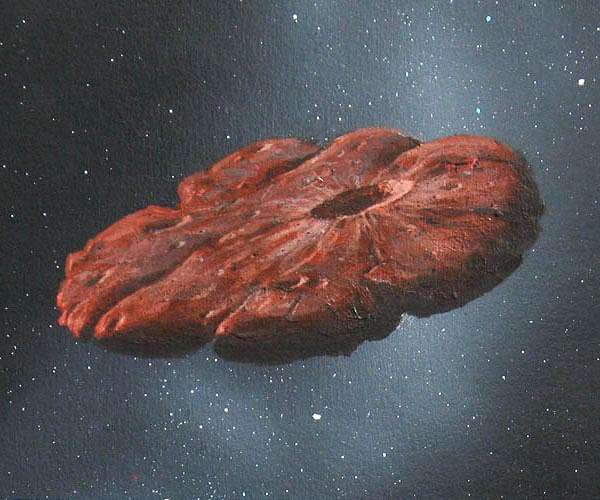 Fig. 4. ’Oumumua as a thick disc. Painting by William K. Hartmann, senior scientist emeritus, Planetary Science Institute, Tucson, Arizona, commissioned by Michael Belton. © William K. Hartmann, 2018. Reproduced with permission.
|
Nevertheless, it’s clear from the press coverage that the solid nitrogen is being taken as a complete explanation. Jackson and Desch dismiss it simply because we haven’t seen extraterrestrial solar sails before, whereas we have seen nitrogen ice on Triton and Pluto (but not free-flying in space). The May 2021 issue of Astronomy Now adds for good measure that Loeb offered no evidence for the extraterrestrial hypothesis, (36) even though he has produced a book full.(19) That article and others are accompanied by the painting by William K. Hartmann, portraying `Oumuamua as a thick disc (Fig. 4), and although he was responsible for the suggestion that its shape might be due to interstellar erosion, he was illustrating Michael Belton’s findings rather than the nitrogen iceberg hyothesis.(19a) At this point, I would add an aphorism of my own, based on painful experience: “A hypothetical natural explanation is not a disproof of a hypothetical artificial one.” Indeed one might add, especially if the explanation is inadequate.

Fig. 5. Flexible Dyson sphere hexagrams, illustrating ‘Empress of the Starlight’, story by G. David Nordley, Analog, Nov/Dec 2018. © G. David Nordley. Reproduced with permission.
Astronautical Explanations
There is one alternative to the solar sail hypothesis, something else which might fit the physical description…
In the Nov/Dec 2018 issue of Analog there was a novella by G. David Nordley, ‘Empress of Starlight’,(37) which was a Hugo Awards finalist the following year. The story has a new take on the Dyson Sphere, breaking up the planets of a solar system to build a shell around the star, to harness all of its radiation output. The problem is that if the sphere is solid and stationary, it will fall into the star ( Larry Niven belatedly recognised and remedied that in The Ringworld Engineers). If it’s rotating, it will shear and disintegrate unless it’s made of something with apparently impossible strength. (Dyson remedied that by substituting a sphere of asteroids for the solid shell.)(38) Instead, Nordley proposes a sphere of flexible, interlinked hexagons (Fig. 5), sustained by sunlight pressure from below and therefore self-correcting if disturbed. In his SF novella, the purpose of this particular Dyson sphere is unclear, except that it is part of an enormous weaponising programme by an ancient, possibly extinct, alien race. In the Preface to his book Around Alien Stars, Nordley comments, “To think of a Dyson sphere as just a source of energy for billions of space colonies seems a bit quaint”. Be that as it may, since the sphere isn’t rotating, a hexagon which was cast loose for any reason (possibly a passing stray planet, as above), would travel radially away from the star until it reached escape velocity, or until the hole it left was plugged. Such a stray plate could be considered as a solar sail, once it was adrift, although it wasn’t intended to be one.
However, that brings us up against the major problem, which applies to all of the ‘natural’ explanations and also needs further consideration for the artificial one, in ways which I’m not sure that Prof. Loeb has done. If discarded, or shocked loose from its Dyson sphere, Nordley’s plate would not be likely to remain perpendicular to the light-beam from the hole (and so avoid being affected by the star’s wind), unless it had attitude control, which it would not have needed when it was locked into place. Travelling around our Sun at perihelion and then outwards on a hyperbolic trajectory, it could not remain perpendicular to the incident sunlight, any more than my comet’s terminator could remain stationary in ‘The Comet, the Cairn and the Capsule’. Even if it wasn’t rotating with a period as long as 8 hours, its reflective area with respect to the Sun would keep changing and the acceleration would have to vary in consequence. Yet Prof. Loeb is insistent that there was no such variation, indexing the matter eight times and stating explicitly at one point that the acceleration was absolutely smooth. To achieve that `Oumuamua has to maintain a constant surface area facing the Sun while also rotating as seen from Earth, and even for artificial explanations that’s something of a challenge, leading us out on a speculative limb, further even than Prof. Loeb goes himself.
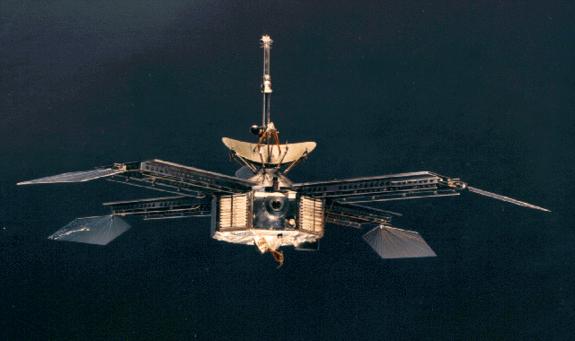 Fig. 6. Mariner 4, showing vanes on solar panels to control attitude by sunlight pressure. © NASA. Used here under its non-commercial use terms. |
To maintain a constant attitude to the Sun in interplanetary orbit, a flat plate solar sail (like the ones orbited by the NASA and Planetary Society) would need adjustable vanes at the corners, like the ones tried out on the solar panels of Mariner 4 (Fig. 6). They proved effective, but unnecessary, so subsequent conventional probes have relied on attitude control jets. Japan’s Akatsuki probe to Venus used attitude control jets, but presumably that’s not an option for `Oumuamua. Such a configuration could explain the constant acceleration, but not if the sail was tumbling.
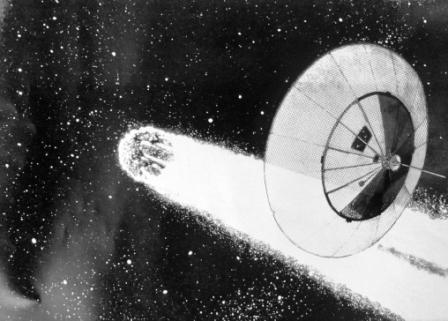 Fig. 7. Solaris parabolic sail ‘Comet-Chaser’, designed by Gordon Ross. Painting by Sydney Jordan for ‘Keep Watching the Skies!’, op cit, reprinted in Duncan Lunan, Incoming Asteroid! What could we do about it?, op cit. 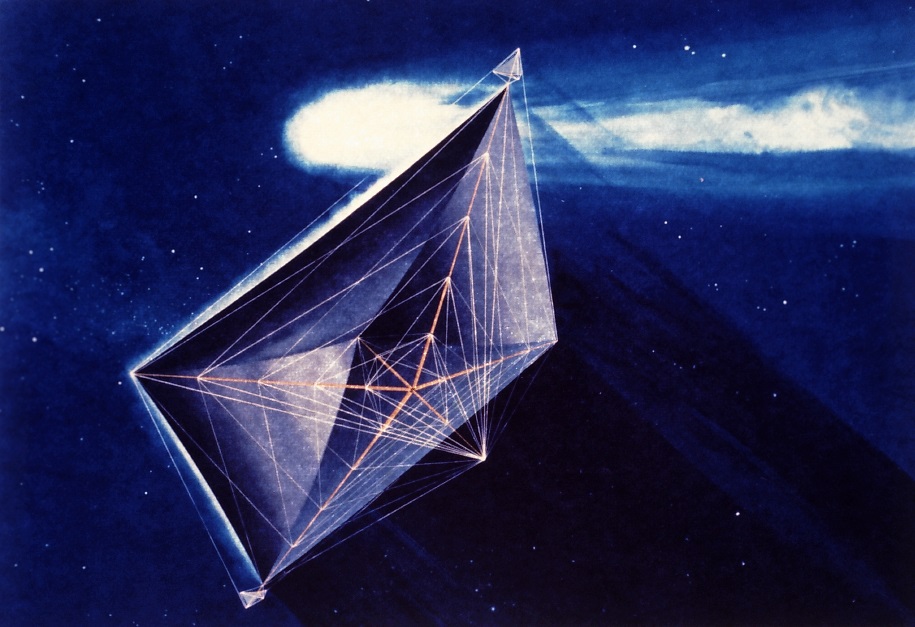 Fig. 8. Halley's Comet solar sail (note attitude control tip-vanes). © JPL/NASA 1979. 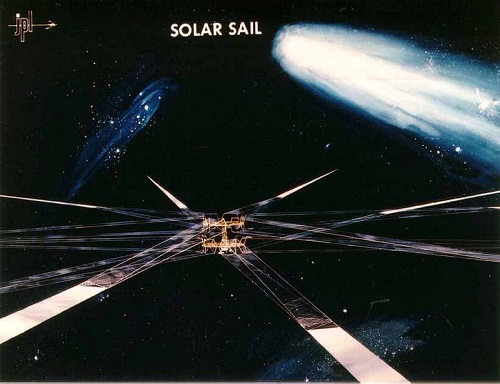 Fig. 9. Heliogyro solar sail alternative for the Halley's Comet mission. © JPL/NASA 1979. |
Likewise a parabolic sail, like the Solaris ‘Comet-Chasers’ designed by Gordon Ross(37, 40) (Fig. 7), could achieve the required changes of orientation either by adjusting the tension on shroud lines, if they have them, or by varying the pressure in gas-filled ribs, but again could not explain the observed variation of the light-curve unless it was tumbling, in which case the acceleration would not be constant.
When the Jet Propulsion Laboratory (JPL) was planning a US mission to Halley’s Comet, the propulsion was to be either an ion-drive or a solar sail. The sail might have been a flat sheet with tip-vanes (Fig. 8), but a more advanced design called the ‘Heliogyro’ would have had individually adjustable vanes and be spun to keep them under tension (Fig. 9). Both the solar sails and the ion-drive were ruled to be too little-tried to justify risking given the expense of a Halley’s Comet mission. I was at JPL in 1979 when news of the cancellation came through, spreading deep disappointment through the buildings. Both methods of propulsion have been proven, and used on deep-space missions since, though all the solar sails to date have been flat sheets. But, rotating for stability and to keep the long vanes under tension, the Heliogyro could turn most of them to the Sun for continuous propulsion, and angle others for navigation, ringing the changes as it rotated - just what `Oumuamua would need to keep thrusting as it moved outward on its hyperbolic path, even though it was rotating and spin-stabilised. For `Oumuamua, either the flat sail with tip-vanes or the Heliogyro would require components of the sail to be active and mobile; at a pinch they might be self-correcting, but inevitably one starts to think of artificial intelligence.
Perhaps ’Oumuamua could be a faceted spheroid of hexagons, like a much smaller version of Gerry Nordley’s Dyson Sphere. If the facets could both absorb and emit radiation, as the spheroid rotated one or more of them could be absorbing solar power while the reflected portion of the sunlight provided propulsion, and others could be tracking and transmitting data to any distant target on the celestial sphere, undetectable from here unless the beam happened to sweep across the Earth. To explain the light-curve fully the spheroid might have to be patterned, as the Apollo spacecraft were to assist temperature control (creating a problem in the early return of Apollo 13). Or perhaps the hexagons could be individually articulated, changing their orientation to the Sun as the sphere rotated. I have no idea whether a faceted sphere could be a possible alternative solution to the observational data, but it would particularly interest me if it were, in relation to an article I published in 1988, too long to go into here.(41)
 Fig. 10. Fig. 10. A ‘murmuration’ of starlings: a flock apparently under central control but actually its individuals just keeping distance from one another.© A. Rasmussen Wikipedia, Public Domain Attribution-ShareAlike 2.0 Generic (CC BY-SA 2.0) |
Still another idea, which Prof. Loeb examined and rejected, (35) was that `Oumuamua could have disintegrated during perihelion passage, and what was being tracked was a cloud of small particles. When that happened with Comet ISON in 2013, the cloud dispersed and became invisible very quickly. If `Oumuamua was a cloud, there has to be an explanation for its remaining together and remaining so bright. One possibility (ironic, in view of the ‘hammer’ gibe above) is that it might be a cloud of Starshot-type mini-sails, acting under central control, and manoeuvering like a flock of starlings (Fig. 10), a shoal of fish, bats rising from a roost, or (possibly) clouds of plasma which give the impression of tornadoes on the Sun, but don’t show the right spectral shifts for spiral motion. (42) At any given time, some of them could be under solar propulsion and others sending data, changing places as they overtake one another, perhaps (like the examples just given) looking like a single body when actually they’re all in motion with respect to one another. Given the small size of the mini-sails, 8 hours seems a reasonable turnover time for the continual front-to-back rearrangement, especially if the swarm’s overall appearance from a distance is a thin disc. It’s possible, again, to imagine the individual processors acting in concert to produce an apparently concerted effect, like a shoal or a flock, but some kind of central processing seems more likely.
Purposeful Explanations
What all these alternative designs for `Oumuamua have in common, trying to account for the observed characteristics, is that (with the possible exception of the patterned, faceted spheroid) they all imply some measure of active attitude control. The solar sails with tip-vanes, the Heliogyro and the unpatterned spheroid with the articulated segments, could all be self-correcting, the mini-sails could be obeying simple position-keeping programming, but following Theodore Sturgeon’s dictum ‘Ask the next question’, we have to ask, was that control purposeful? If the spacecraft or swarm was transmitting data to some distant collecting point, then it would have to have position-keeping.
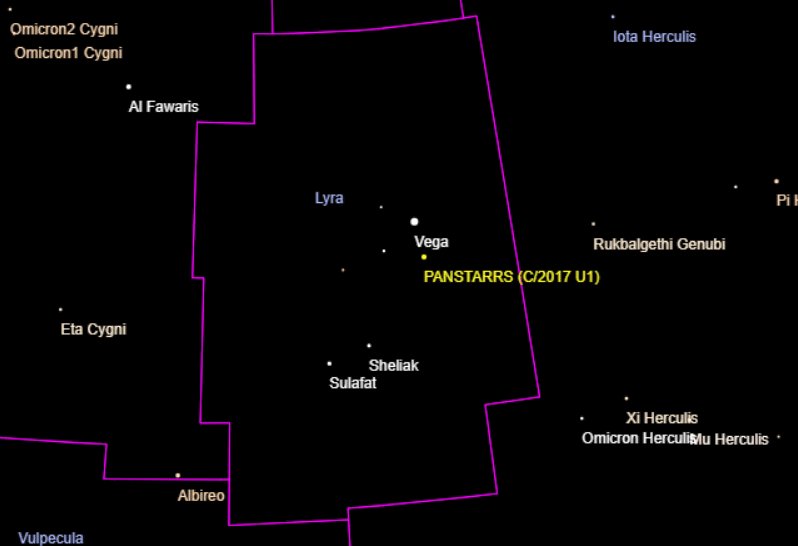
Fig. 11. ’Oumuamua point of origin in Lyra, later exiting towards Pegasus.
We have to think about where it came from; not those four candidate origin stars, which may not be significant, but where it was immediately before it came into the region of our system’s planets. Most sources say that it came from very near Vega, in the constellation Lyra. Vega is a young blue-white star 25 light-years away, surrounded by a disc of material in which planets may be forming, and `Oumuamua could perhaps have been ejected from there; but the agreement isn’t all that close. `Oumuamua came from R.A. 279°.55, declination 33°.87, and the corresponding figures for Vega (longitude and latitude projected on to the sky) are 270°.61 and 38°.78 (Fig. 11). `Oumuamua’s entry point was a lot closer to the Apex of the Sun’s Way, the point towards which the Solar System is heading. There’s some disagreement about the exact location of the Apex, but the closest fix to `Oumuamua’s entry point is at Right Ascension 277°.5, declination 30°, and its angular separation from it is only 4 degrees.
If `Oumuamua had been detected and tracked from a long way off, that might be as expected. However, it wasn’t detected until it had already passed perihelion, and its closeness to the Apex was discovered when its path was traced back, which is a rather different story. The Sun is moving through the interstellar medium with a velocity of 12.5 miles per second (20 kps). At the point where it began to respond to the gravity of the Sun, was around the year 1605 AD, (32) `Oumuamua had zero velocity up, down or sideways with respect to the galactic plane, but was coming towards us through the interstellar medium with a velocity of 11 kps, giving it a resultant velocity of 26.3 kps with respect to us. (43) It was effectively at the Local Standard of Rest, as Loeb describes it, but it’s something of a relief that it wasn’t precisely stationary in our frame of reference. If it were, and had come precisely from the Apex of the Sun’s Way, one might be forced to say that it wasn’t from interstellar space at all, but, like the tachyon signals in Gregory Benford’s novel Timescape, it was from the future. (44)
Nevertheless, `Oumuamua was almost exactly in the Sun's path. Even a small displacement from that path would have allowed 'Oumumua to enter from any other point on the leading hemisphere of the celestial sphere, causing it to pass the Sun more slowly and at a much greater distance (as my imaginary comet did in ‘The Comet, the Cairn and the Capsule’, taking so long to cross the inner Solar System that it could be intercepted by a beefed-up version of the proposed NERVA manned missions to Mars.)
In a recent online discussion, it was put to me that `Oumuamua’s reflectivity could be explained if it previously had a dark crust, which flaked off during the approach to the Sun. But spalling on that scale would surely affect the orbit, which would have given `Oumuamua a different apparent point of origin, of no particular significance. The loss of the supposed crust might have made it look as if it came from the Apex; the odds against it are very large, but it’s not inconceivable – and that doesn’t, or shouldn’t, mean that therefore it must be what happened, because the alternative (deliberate planning) is unthinkable. As the late poet and artist Matt Ewart said, discussing geometrical alignments in art and in landscape, “The relationships exist. Anyone with a good map and a computer can confirm that they exist, and if we can’t account for that, we have a duty to search for an explanation.” And as the poet Brian Finch added, anticipating the inevitable reply, “To say ‘coincidence’ is not a refutation of an argument, but a refusal to have one”.
For `Oumuamua to have been floating virtually at rest in the interstellar medium, and so closely aligned with the Sun’s path, is either an extraordinary coincidence or it implies deliberate placing. It might tie in with Loeb’s idea that it’s a buoy, or an interstellar beacon – although either would imply that it is indeed still functional. Then it has either been there for a very long time or it was left in the Sun’s Way by accident, which negates purpose, shows astonishing carelessness, and is coincidence piled upon coincidence. As the late A.T. Lawton said, of the possibility of the Solar System forming at the intersection of two supernova shockwaves, “If the probability of one such event is tiny, the probability of two of them coinciding is (tiny) squared.”(45) Meteoritic studies have shown that the Solar System was indeed formed in that way, but it is even harder to imagine that someone would position a buoy in interstellar space, presumably for navigational purposes, and not notice that our star was bearing down on it.
But if it’s possible that `Oumuamua’s path through the Solar System was deliberately chosen, I’m amazed that no-one else has highlighted where `Oumuamua is going as a result of that gravitational slingshot. The scientists who searched the Gaia data for possible origin stars did also look at where it’s bound, (17) and “in just 0.029 Myr (29,000 years) ‘Oumuamua will pass the M5 dwarf Ross 248 at 0.459 pc (1.5 light-years) with a relative velocity of 104 km s-1.” For living beings a 29,000-year wait would be unconscionable, but for an artificial intelligence the time spent in transit is nothing – it is, literally, neither here nor there. But in that time, if the sail or the swarm can adjust its orientation to starlight, probably `Oumuamua can tack to another close encounter, on an odyssey like the Cairn’s in my story, but directed and on a (relatively) much shorter timescale.
Ross 248 is currently one of the closest stars to the Sun, at 3.15 parsecs (10.269 light-years) in Andromeda - a likely target for an interstellar survey deliberately following an odyssey like the Cairn’s, in my story – but in 33,000 years from now, it will be the closest star to the Solar System, passing us at 3.024 light-years 4500 years later.(46) The only closer stars which ’Oumuamua might have targeted, assuming it was targeted, would be Proxima or Alpha Centauri. Ross 248 is a red dwarf star, and therefore likely to have planets, though none have been detected as yet. It does make one wonder what `Oumuamua or its creators may know about it that we don’t.
Any kind of interception of `Oumuamua was out of the question, at such short notice, but chasing it is being investigated as a possibility with near-future technology (‘Project Lyra’).(47) As they say in naval circles, “a stern chase is always a long one”, but it won’t be beyond the Sun’s pull until 2430, (32) which is surely time enough in which to catch up with it. After reading Loeb’s book, the case for sending a mission after `Oumuamua seems a great deal stronger than when I wrote the first draft of this article, two years ago.(48) At the very least – whatever Prof. Loeb’s detractors may say – it looks as if the story is still far from over!
Duncan Lunan
Acknowledgements. Thanks to Sydney Jordan, William Hartmann and David Hardy for permission to reproduce their artwork. Genuinely appreciated.
Duncan Lunan has: published 10 books on astronomy, spaceflight and SF and contributed to 36 more; had 42 published SF stories and; written over 1,600 articles, including a monthly astronomy column ‘The Sky Above You’. He has written numerous SF reviews for Interzone and Shoreline of Infinity, as well as currently non-fiction (in the past also fiction) for SF² Concatenation. He built the first astronomically aligned stone circle in Britain for over 3,000 years (recreated at a new site in 2019), and was a curator of Airdrie Public Observatory for over 18 years. Details of his books and other work are on his website, www.duncanlunan.com, and he can be contacted there or directly at duncanlunan [-at-] gmail [-dot-] com.
Notes & references
1. Clube, V. & Napier, B. (1982) The Cosmic Serpent. Faber: London.
2. Douglas-Home, M. (2011) The Sea Detective. Penguin: London.
3. Byrd, D. (2017) Small Object Visits from Beyond the Solar System. EarthSky, online, October 29th, earthsky.org/space/a2017u1-comet-asteroid-interstellar-beyond-solar-system/ (Accessed September 2021.)
4. Cain, F. (2017) Has the First Interstellar Comet Been Discovered?, Universe Today, online, October 26th. universetoday.com/137621/first-interstellar-comet-discovered/. (Accessed September 2021.)
5. Lunan, D. (1974)‘Derelict’, Amazing, April; reprinted in Lunan, D. (2019) From the Moon to the Stars, Space-travel Stories by Duncan Lunan. Other Side Books: Glasgow.
6. Lunan, D. (1972) ‘The Comet, the Cairn and the Capsule’. If July-August; reprinted in The Science Fictional Solar System (see below) and in Asimov, Greenberg & Waugh (eds) (1986) Comets. Signet: London.
7. Asimov, I. ‘Comets’, in Asimov, Greenberg & Waugh (eds) (1979) The Science Fictional Solar System. Harper & Row: London.
8. Harrison, H & Jordan, S. (1957/8) ‘Out of Touch’, Jeff Hawke strip, Daily Express 4th October ‘57 – 5th April ‘58, reprinted in Jeff Hawke’s Cosmos (2009) vol. 5 (2), pp. 3-33.
9. Cole, D. M. & Cox D. W. (1964) Islands in Space: the Challenge of the Planetoids. Chilton: Philadelphia.
10. Sample, I. (2017) Astronomers to Check Interstellar Body for Signs of Alien Technology; Is ‘Oumuamua an Alien Spacecraft? Initial Scans Show No Signs of Technology. The Guardian 11th December and 15th December.
11. Williams, M. (2017) Updates on `Oumuamua, Maybe It’s a Comet, Actually. Oh, and No Word from Aliens, Universe Today. 19th December. universetoday.com/138108/updates-oumuamau-maybe-comet-actually-oh-no-word-aliens/.(Accessed September 2021.)
12. Williams, M. (2017) That Interstellar Object Is Probably Pretty Strange Looking. Universe Today, 20th November. universetoday.com/137944/interstellar-asteroid-probably-pretty-strange-looking/ (Accessed September 2021.)
13. Byrd, D. (2018) Interstellar Asteroid Update: It’s a Comet!, EarthSky, 28th June.
14. Anon. (1991) News Update: Halley’s Outburst. Astronomy Now, August, p9.
15. Anon. (2018) Interstellar Asteroid `Oumuamua Had a Violent Past. Universe Today, 16th February. universetoday.com/138555/oumuamua-had-a-violent-past-1/ (Accessed September 2021.)
16. Byrd, D. (2018) Researchers Say 1st Interstellar Asteroid Likely from Double Star. EarthSky, 19th March.
17. Bailer-Jones C. A. L., Farnocchia, D., Meech, K. J. et al (2018) Plausible Home Stars of the Interstellar Object `Oumuamua Found in Gaia DR2. Astronomical Journal, vol. 156 (5) 205.
18. Loeb, A. (2018) How to Search for Dead Cosmic Civilisations, Scientific American. September 27th; Bialy, S. & Loeb, A. (2018) Could Solar Radiation Pressure Explain 'Oumuamua's Peculiar Acceleration?, The Astrophysical Journal Letters, vol. 868 (1), DOI:10.3847/2041-8213/aaeda8; Williams, M. (2018) Could ’Oumuamua Be an Extra-Terrestrial Solar Sail?, Universe Today, 31st October universetoday.com/140391/could-oumuamua-be-an-extra-terrestrial-solar-sail/ (Accessed September 2021.); Anderson, P. S. (2018) Could ’Oumumua Be an Interstellar Light Sail?, EarthSky, November 6th. earthsky.org/space/could-oumuamua-be-an-alien-lightsail/ (Accessed September 2021.)
19. Loeb A. (2021) Extraterrestrial: The first sign of intelligent life beyond Earth. John Murray: London.
19a. Hartmann, W. A. (2021) personal correspondence.
19b. Belton, M. et al. (2018) The Excited Spin State of 1I/2017 U1 ‘Oumuamua. Astrophysical Journal Letters, vol. 856, L21.
20. Lunan, D. (1973) Space Probe from Epsilon Boötis, Spaceflight, April; reprinted International Space Report, January 1974, Pursuit, 1975.
21. Lunan, D. (1974) Man & the Stars: Interstellar contact and communication Souvenir Press: London.
22. Lunan, D. (1976) Long-Delayed Echoes and the Extraterrestrial Hypothesis. Journal of the Society of Electronic and Radio Technicians, September. vol. 10 (8) p180-182.
23. Google ‘Black Knight’, or even my name, and innumerable examples will be found. For the truth about the supposed ‘Black Knight’, look for its page on the left-hand column of my homepage, duncanlunan.com, or the fuller explanation as a sub-file of the ‘Man and the Stars’ page, further up the left-hand column. (If reading this in the far future then use The Way Back Machine to search for duncanlunan.com.)
24. Lunan, D. (1979) ‘Past Contact and the Moving Caravan’ (chapter), in Boyce, C. (1979) Extraterrestrial Encounter. David & Charles Ltd.: Newton Abbot.
25. Kopal, Z. (1972) Man and His Universe. Rupert Hart-Davis: London
26. Agel, J. (ed.) (1970) The Making of Kubrick’s 2001. Signet: London.
27. Frewin, A. (ed.) (2005) Are We Alone? The Stanley Kubrick extraterrestrial intelligence interviews. Elliott & Thompson: London.
28. Williams, M. (2018) `Oumuamua Was Just the Beginning: astronomers find an interstellar asteroid orbiting retrograde near Jupiter. Universe Today, 23rd May. universetoday.com/139285/oumuamua-was-just-the-beginning-astronomers-find-an-interstellar-asteroid-orbiting-retrograde-near-jupiter/ (Accessed September 2021.); Williams, M. (2018) The Solar System Probably has Thousands of Interstellar Asteroids. Universe Today, 7th February. universetoday.com/138494/solar-system-probably-thousands-captured-interstellar-asteroids/. (Accessed September 2021.)
29. Anon. (2012) Interstellar Comet Was Exceptionally Pristine. Astronomy Now, May, p.20.
30. Hoang, T. & A. Loeb, A. (2020) Destruction of Molecular Hydrogen Ice and Implications for 1I/2017 U1 (’Oumuamua). Astrophysical Journal Letters, vol. 899, L23.
31. Jackson A. P. & Desch S. J. (2021) 1I/’Oumuamua as an N2 Ice Fragment of an Exo-Pluto Surface: I. Size and Compositional Constraints. Journal of Geophysical Research: Planets, vol. 126, e2020JE006706; and Desch, S. J. & Jackson A. P. (2021) 1I/’Oumuamua as an N2 Ice Fragment of an Exo-Pluto Surface II: Generation of N2 Ice Fragments and the Origin of ’Oumuamua. Journal of Geophysical Research: Planets. vol.126, e2020JE006807.
32. Petrov, A. (2021) ’Oumuamua Finally Explained Using a Brilliant Analysis Anton Petrov. youtube.com/watch?v=hkZRUs8A_9Q. (Accessed September 2021.)
33. Wright, L. (2001) ‘Why Don’t We Ask the Dinosaurs?’ in British Rocketry Oral History Project, Asteroid Impact seminar, Charterhouse School. 12th April.
34. Latham, P. (1949) The Aphrodite Project. Astounding Science Fiction (UK edition), October.
35. Cain, F. (2021) Interview: On ’Oumuamua, aliens and astrophysics, with Dr. Avi Loeb. Online, Universe Today, April 9th. URL
36. Anon. (2021) News: Was ’Oumuamua a Nitrogen Iceberg from a Pluto-like Planet? Astronomy Now, May, p20.
37. Nordley, G. D. (2018) ‘Empress of Starlight’, Analog Nov/Dec; Nordley, G. (2019) 'Preface', in Nordley, G. D., Around Alien Stars. Brief Candle Press: Monce, IL.
38. F.J. Dyson, The Search for Extraterrestrial Technology, in Marshak, R. E. (ed.) (1966) Perspectives in Modern Physics. Interscience Publishers: New York.
39. Lunan, D. & Ross, G. J. (1964)‘Keep Watching the Skies’, Analog, October; extended version (2002) Cambridge Conference Net, online. defendgaia.org/bobk/ccc/ce031902.html. (Accessed September 2021.)
40. Lunan, D. (2013) Incoming Asteroid! What could we do about it? Chap. 5. Springer: London.
41. Lunan, D. (1998) Epsilon Boötis Revisited. Analog, March; online at www.duncanlunan.com/epsilonbootis.asp. Summarised in Lunan, D. (2012) The Stones and the Stars, Building Scotland’s Newest Megalith Chap. 5. Springer: London, and with more detail in Lunan, D. (2012) Children from the Sky Chap. 21. Mutus Liber: London & Edinburgh.
42. Labrosse, N. (2017) ‘Solar Tornadoes’ (lecture), Astronomers of the Future Club. Troon, 30th November.
43. Mamajek, E. (2017) Kinematics of the Interstellar Vagabond 1I/`Oumuamua (A/2017 U1). Research Notes of the American Astronomical Society, vol.1, 1 (November).
44. Benford, G. (1980) Timescape. Simon & Schuster: London.
45. Lawton, A. T. quoted in Lunan, D. (1983) Man and the Planets (Chap. 13). Ashgrove Press: Bath, Somerset.
46. ‘Ross 248’, entry in Wikipedia. en.wikipedia.org/wiki/Ross_248 (Accessed September 2021.)
47. Williams, M. (2017) Project Lyra, a Mission to Chase Down That Interstellar Asteroid. Universe Today. 23rd November. universetoday.com/137960/project-lyra-mission-chase-interstellar-asteroid-1/.(Accessed September 2021.)
48. Lunan, D. ‘Interstellar Messengers’, in From the Moon to the Stars, op cit.
[Up: Article Index | Home Page: Science Fact & Fiction Concatenation | Recent Site Additions]
[Most recent Seasonal Science Fiction News]
[Convention Reviews Index | Top Science Fiction Films | Science Fiction Books]
[Science Fiction Non-Fiction & Popular Science Books]